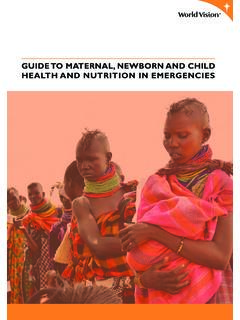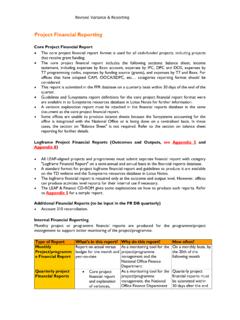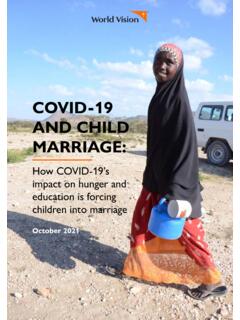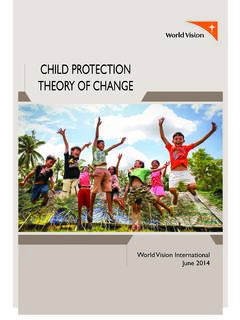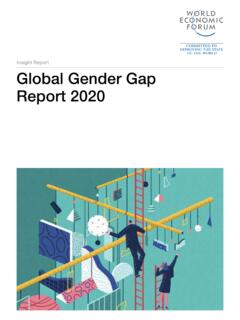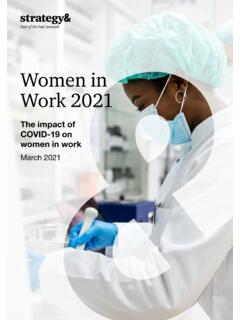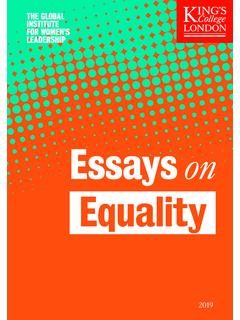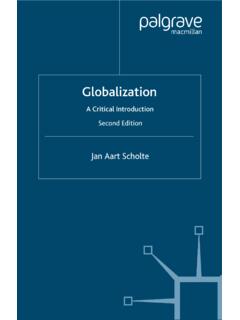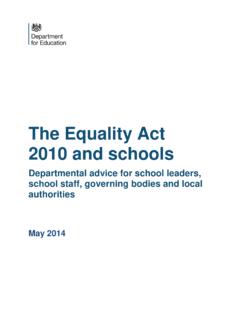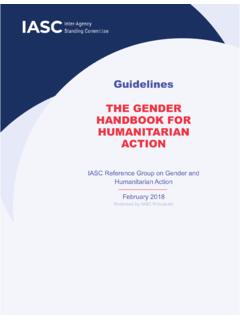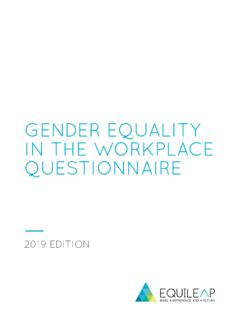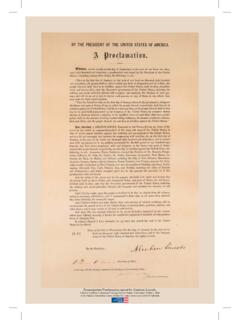Transcription of Gender Training Toolkit - World Vision International
1 Gender Training ToolkitSecond edition1 Gender Training ToolkitIntroduction SectionSecond editionCopyright World Vision International Copyright 2008 by World Vision by World Vision International , 800 W. Chestnut Avenue, Monrovia, CA 91016, by the WVI Gender and Development Department on behalf of the World Vision adapted material is reproduced from the Oxfam Gender Training Manual, 1995, with the permission of Oxfam GB, 274 Banbury Road, Oxford, OX2 7DZ, UK, in chief: Edna Valdez. Senior editor: Rebecca A. Russell. Production management: Jim McAllister. Copyeditor: Randy Miller. Graphic designer: Judy Walker. Proofreader: RLou credits: Marco Cedillo, Karl Grobl, and Edna Valdez for World ..3 ForeWord ..4 PreFACe.
2 5 InTroduCTIon Why Gender and Development? .. 7 World Vision s Response: Gender and Development Training .. 8 Linking the Gender Training Toolkit to World Vision s Integrated Focus: Christian, Child-centered and Community-based ..8 Linking the Gender Training Toolkit to World Vision s Programming Tracks: Transformational Development, HEA and Advocacy ..8 Linking the Gender Training Toolkit to LEAP ..9 Audience for the Gender Training Toolkit .. 9 Gender Training Toolkit Objectives .. 10 Gender Training Toolkit Components .. 11 Core Curriculum in the Gender Training Toolkit .. 12 10 Easy Steps for Preparing Your Training Session .. 13 Helpful Hints for Facilitators ..14 Core Curriculum: Descriptions of Modules and Sessions.
3 17 Training Design for the Gender Training Toolkit .. 24module 1 Why Gender And deVeloPmenT (GAd) IS ImPorTAnT To our Work 1 .1 World Vision s Mission Statement, Core Values and GAD Policy ..35module 2 Gender And BIBlICAl reFleCTIon 2 .1 From Genesis to Galatians .. 51 2 .2 Incarnational Power: The Magnificat ..57 2 .3 Jesus Challenges the Gender Dynamic .. 60 2 .4 Gender Imagery in the New Testament ..65 2 .5 Scripture Search in the Community: Using a Gender Lens .. 69module 3 Gender And deVeloPmenT ConCePTS 3 .1 Sex and Gender Roles ..77 3 .2 The Road from WID to GAD: Key Definitions for Gender and Development ..83 3 .3 Practical Gender Needs and Strategic Gender Needs .. 89 3.
4 4 Women s Triple Role .. 92module 4 Gender AnAlySIS ToolS 4 .1 An Introduction to Gender Analysis Tools .. 102 4 .2 Introduction to The Harvard Analytical Framework .. 113 4 .3 The Harvard Analytical Framework: Activity Profile .. 115 Contents2 4 .4 The Harvard Analytical Framework: Access and Control Profile .. 121 4 .5 The Harvard Analytical Framework: Analysis of Factors Influencing Activities, Access and Control ..124 4 .6 The Harvard Analytical Framework: Project Cycle Analysis .. 127 4 .7 The Harvard Analytical Framework: Project Application Session .. 131 4 .8 The Gender Analysis Matrix ..135 4 .9 Empowerment: Goals, Definitions and Classifications ..143 4 .10 equality and Empowerment Framework (EEF).
5 147 4 .11 Participatory Learning Approach and Gender Analysis .. 152 4 .12 The 24-Hour Day .. 158 4 .13 Transformational Development Gender -Sensitive Indicators .. 163module 5 mulTI-SeCTorAl Gender AWAreneSS: Women AS PeACemAkerS, heAlTh, hIV And AIdS, med, eduCATIon 5 .1 Women as Peacemakers .. 177 5 .2 Gender Analysis and Health ..182 5 .3 Gender Analysis and HIV/AIDS .. 188 5 .4 Gender Analysis and Microenterprise Development (MED) .. 193 5 .5 Gender Analysis and Education ..200module 6 GIrlS And BoyS AS AGenTS oF ChAnGe 6 .1 Empowering Girls and Boys What Difference Does it Make? ..211 6 .2 Key Concepts, Types, Methods and Guidelines for Full Participation of Girls and Boys.
6 222 6 .3 Using Gender Analysis with Girls and Boys .. 232 module 7 Gender And AdVoCACy 7 .1 GAD and Advocacy in World Vision An Introduction .. 239 7 .2 World Vision s Categories of Advocacy Practise Link to Gender Advocacy ..247module 8 Gender And heA 8 .1 Introduction to Gender and Humanitarian & Emergency Affairs (HEA) .. 265 8 .2 Gender Considerations in HEA Programming and Planning .. 272 8 .3 The Capacities and Vulnerabilities Framework ..285 APPendIx: GloSSAry .. 2883I would like to express my deep appreciation to the Gender Training Toolkit Core Working Group for their invaluable input and commitment and to all those who contributed to the research and writing of this Toolkit .
7 The Core Group was comprised of Barbara Frost, Victor Madziakapita, Dilsy Arbutante, Grace Hukom, Clare Seddon, Joyce Jackson, Assan Golowa, Karoline Davis, Albana Dino, Edward Mubiru, Natalia Buratti, Ruthi Hoffman, Annastacia Olembo, Remedios Geraldes, Julienne Mata, Joven Opon, Reynor Imperial and Jerry Gabriel. I am extremely grateful to Barbara Frost who designed the curriculum and the facilitators guide, and who worked closely with me and contributed significantly to the development of this Toolkit . I would also like to thank Patricia Morris and Kebokile Dengu-Zvobgo for their invaluable advice, input and comments on earlier drafts of various modules and sections; and to Jessica Simpson, who contributed to the research and documentation of this Toolkit on earlier drafts of the first edition of this HashiDirector, Gender and Development World Vision InternationalAcknowledgements4 Our Christian foundations and witness, and our learning from World Vision s journey in development lead us to acknowledge our responsibility to fully embrace, model and apply the very best practices in Gender and Development in all our requires that we actively identify and disseminate that learning so we waste no time in sharing our best with those we are called to serve.
8 The following second edition of the Gender and Development (GAD) Training Toolkit encompasses decades of deep field experience, learning from others and our own journey in ever better appreciating the roles and gifts that women and girls, men and boys bring to sustainable development and human transformation. It represents yet another milestone in codifying the insight and progress we have made since World Vision declared its commitment to women in development (WID) in the early encourage all of us to reflect on the theological grounding for transformed Gender dynamics and to better understand, model and apply GAD learning in all our work and want to thank Fatuma Hashi, the Partnership s leader for Gender and Development, for her initiative in leading this second edition, and all those whose field experience, effort and support contributed to the content and production of this YoungSenior Vice President Integrated Ministry and Strategy World Vision InternationalForeword5 World Vision , an International Christian NGO with a commitment to transformational development, recognises Gender and development (GAD)
9 As an essential and critical component of its ministry. As a widely referenced social transformation theory, Gender and development focuses not on the needs of women and girl children in isolation, but on Gender relationships among men and women, boys and girls in the context of their families and communities. In this, GAD theory shares much in common with Christian ideas of reconciliation, justice, and the notion of being co-stewards of God s resources and co-heirs of God s more than half a century, World Vision has accumulated experience in working with children and families around the World to build hope, to provide sustainable access to food and clean water, to promote MED and provide education and basic health necessities for a better future, and more.
10 Through its work with communities, World Vision has learned that women and girls are often the most marginalized and discriminated against within a given population. Nevertheless, these women and girls hold the keys to the future for their entire communities. If women are literate, their children will be too; if girls are protected and well cared for, boys will be too. Additionally, when women are encouraged in leadership and responsibilities, this new power for transformation inevitably benefits men in their communities as so, for more than a decade, World Vision staff has been accumulating knowledge and experience in Gender Training and capacity building. In 1992, the World Vision International Board adopted a women in development policy for the entire partnership.

